Key takeaways:
- Color psychology significantly influences emotions and storytelling in photography, impacting viewers’ emotional responses and narrative perception.
- Effective use of color, including complementary schemes and monochromatic palettes, can enhance visual appeal and guide viewers’ focus within an image.
- Personal experiences with color often evoke strong memories and feelings, demonstrating the powerful connection between colors and emotions in visual art.
- Pre-visualization and post-processing adjustments play crucial roles in harnessing color to elevate the emotional impact of photographs.
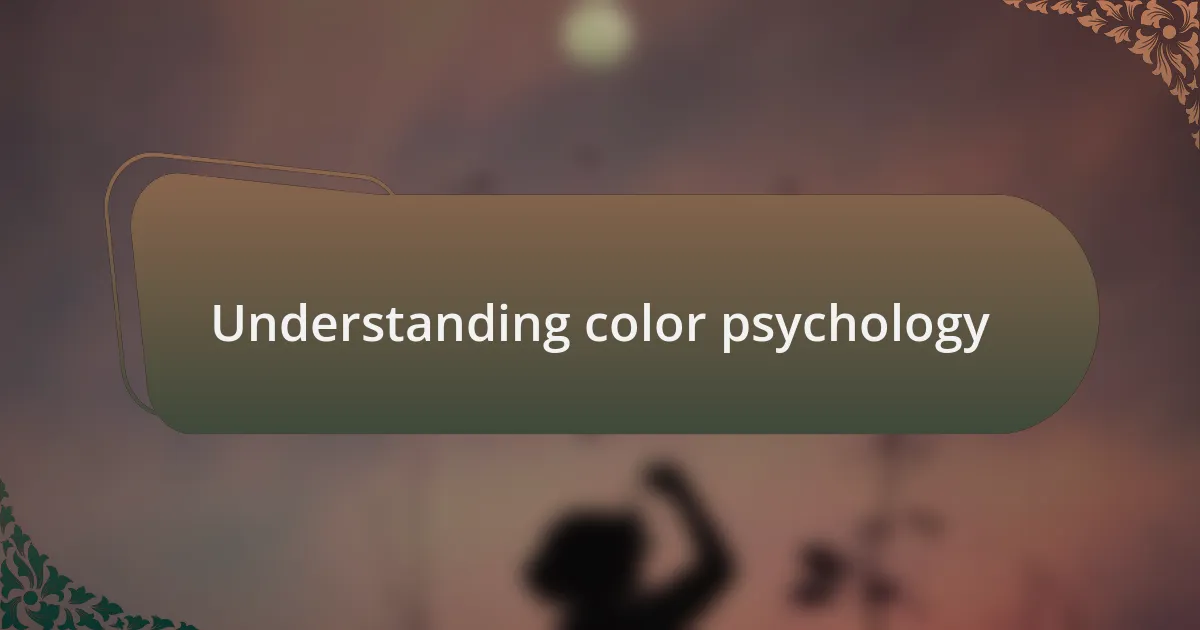
Understanding color psychology
Color psychology is a fascinating field that delves into how colors influence our emotions and behaviors. For instance, when I photograph a serene landscape at sunset, the warm hues of orange and pink evoke feelings of peace and nostalgia within me. Have you ever noticed how certain images make you feel instantly happy or calm? That’s the power of color.
When I think about red, it’s a color that immediately grabs attention and ignites passion. In my own experience, capturing an intense red flower against a muted background creates a stunning focal point that almost demands to be noticed. Isn’t it interesting how something as simple as color can transform the mood of a photograph?
Understanding color psychology also plays a crucial role in storytelling through photography. I often select colors that resonate with the narrative I want to convey. For example, using cool blues can communicate tranquility and trust, while vibrant yellows can evoke cheerfulness. How about you? What colors do you gravitate towards in your own captures, and what stories do you think they tell?
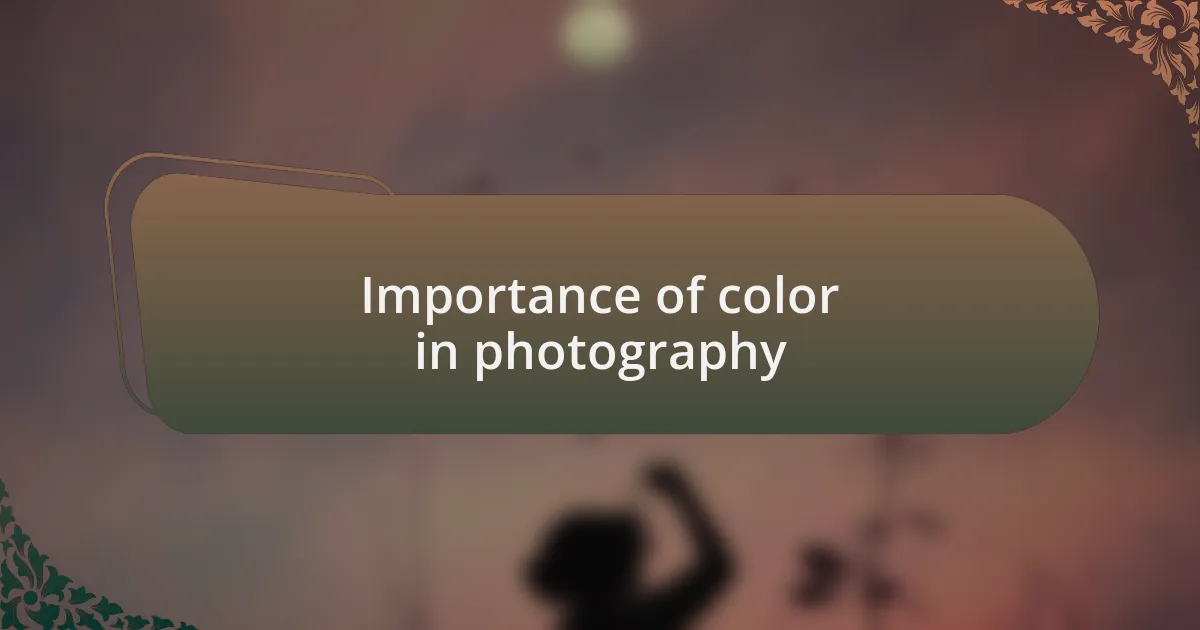
Importance of color in photography
When it comes to photography, color is not just an aesthetic choice; it profoundly impacts the viewer’s emotional response. I remember capturing a foggy morning where muted greys and soft blues dominated the scene. The cool tones imparted a sense of calm and solitude, making the viewer resonate with the isolation of that moment. Have you ever experienced the way certain colors can transform a photograph into a mood or a feeling?
Moreover, color can guide the viewer’s eye and highlight key elements within a composition. For instance, I once photographed an ancient stone wall adorned with vibrant green moss. The color contrast not only drew attention to the intricacies of the texture but also invoked a sense of history and life in a seemingly still environment. Isn’t it fascinating how color can dictate where we focus our attention in an image?
Delving into the psychological associations of color enriches the storytelling aspect of photography. Imagine capturing a playful scene with bright, saturated colors; they immediately inject energy and excitement. In my experience, adjusting the color palette can alter the entire narrative. What stories do the colors in your images tell? Have you considered how their emotional weight influences the moments you choose to capture?
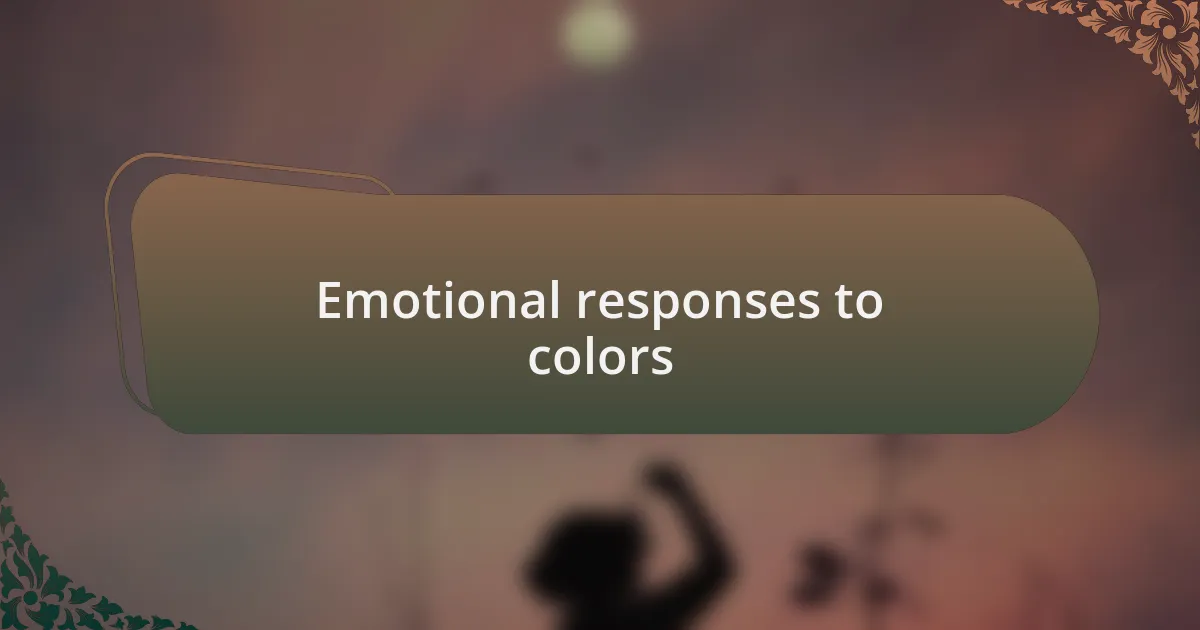
Emotional responses to colors
Colors evoke deep emotional responses that can shape how we perceive a photograph. I recall taking a portrait bathed in warm, golden hues during sunset. The soft light not only highlighted the subject’s features but also created an inviting atmosphere that felt like a warm embrace. Have you ever noticed how colors can make you feel like you’re part of a moment, almost as if you could touch the emotions captured within the frame?
Consider the power of red in photography; it often signifies passion or urgency. I experimented with a striking image of a red bicycle leaning against a faded wall, invoking a sense of nostalgia and longing. That single color drew viewers in, sparking their imaginations and allowing them to project their own memories onto the scene. Isn’t it intriguing how a simple choice in color can shift the entire narrative from merely observing to emotionally connecting?
The calmness of blue, on the other hand, can foster feelings of tranquility and trust. I once captured a serene lake reflecting a clear blue sky, which instantly transported viewers to a peaceful haven. It’s fascinating how these emotional responses can be almost universally understood. Have you thought about how the colors you choose to dominate your scenes impact not only your vision but also the viewer’s experience? This interplay between color and emotion is a powerful tool in photography that can transcend mere visual appeal.
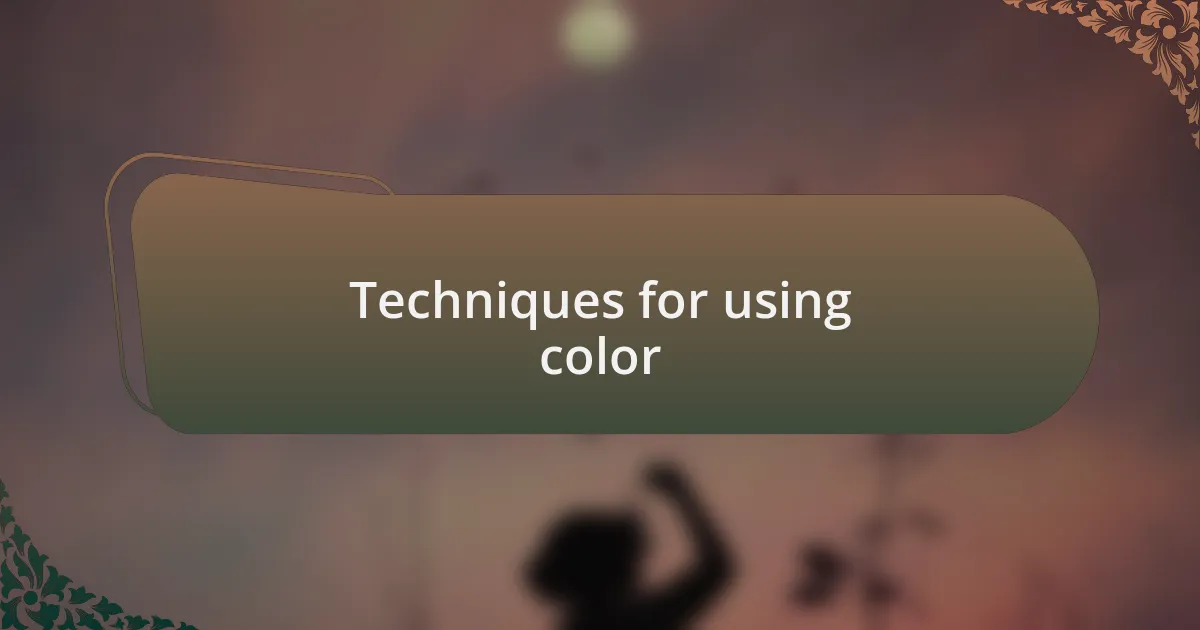
Techniques for using color
Utilizing color effectively requires a keen understanding of its emotional resonance. I often find that balancing complementary colors can create striking visuals. Once, I shot a vibrant sunset where the deep orange hues met the cool blues of twilight. This contrast not only captivated the viewer’s eye but also invoked a sense of harmony and balance, almost like a dance between warmth and calm.
Incorporating monochromatic schemes can also be a powerful technique. I recall a series where I focused solely on different shades of green in a lush forest setting. The result was a cohesive narrative that subtly conveyed freshness and renewal. It’s remarkable how limiting color can actually enhance overall depth and engagement. Have you ever considered how working within a single color family might elevate your own projects?
Another method I cherish is the strategic use of color to lead the viewer’s eye. During one wedding shoot, I made sure to highlight the bride’s flowing, ruby-red dress against a drab background. This not only drew attention to her but also emphasized the joy and vibrancy of the occasion. How do you think a deliberate splash of color could change the focus in your own photography? The answer often lies in careful planning and a bit of creative intuition.
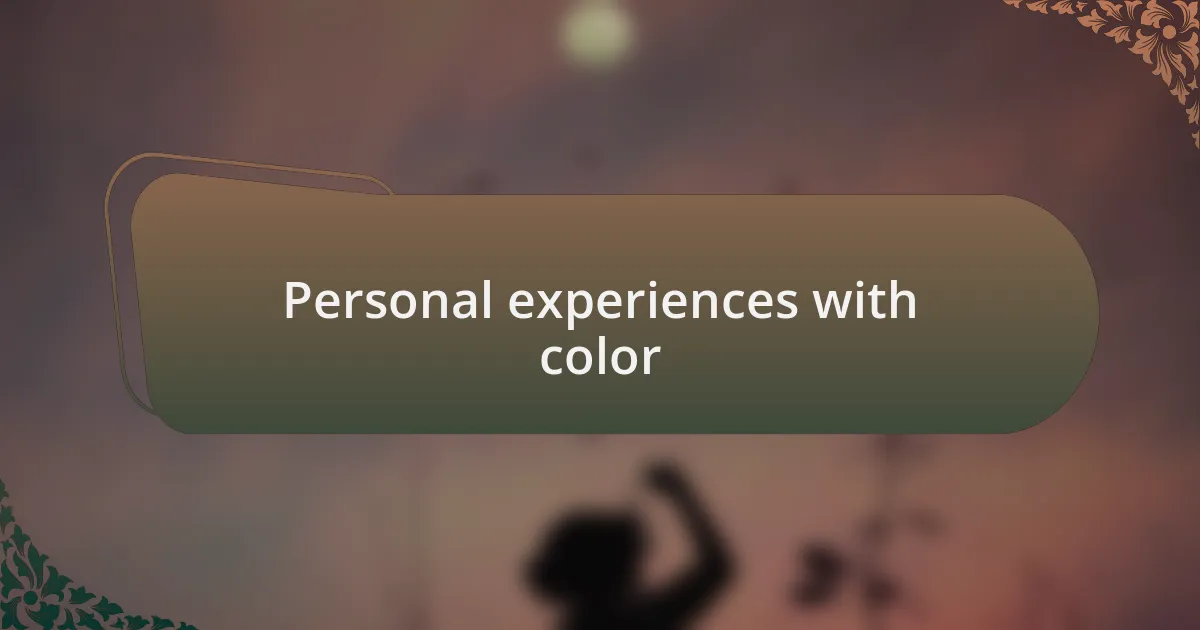
Personal experiences with color
I’ve had moments where color seemed to wrap itself around my experiences like a warm blanket. For instance, during a street festival, the electric blues and fiery reds of the decorations struck me deeply, making everything feel more alive. It was as if the colors were whispering stories of joy and celebration, transforming the ordinary into something extraordinary. How often do we overlook the vibrancy in our surroundings?
In another instance, while capturing an autumn landscape, the golden yellows and burnt oranges of the leaves evoked an overwhelming sense of nostalgia for me. Those colors not only highlighted the beauty of the changing seasons but also tugged at memories of past family gatherings. It’s interesting to consider how colors can trigger emotions and memories; do you ever find certain hues reminding you of specific moments in your life?
I also remember the impact of vibrant colors while shooting portraits against brightly painted walls in a bustling neighborhood. The deep teal background brought out the subjects’ expressions in a way I hadn’t anticipated, infusing their personality into each frame. Seeing their smiles come alive against such a backdrop made me realize how much color can enhance not just a photo but the very essence of the moment captured. Have you ever thought about how a simple change in background color could transform an image and its emotional impact?

Impact of color choices
When I consider the impact of color choices in photography, I often reflect on a vibrant market scene I captured in Morocco. The rich reds and yellows of spices, coupled with the jade greens of the surrounding foliage, created a dynamic visual feast. It was fascinating to see how those colors not only drew the eye but also elicited curiosity and excitement, making me more immersed in the atmosphere of the place. Have you ever noticed how certain color combinations can instantly transport you to another world?
In another experience, I used muted tones during a winter shoot filled with soft greys and icy blues. This choice brought a sense of serenity and calmness to the images, evoking feelings of solitude and reflection. It’s intriguing how such subtle color palettes can shift the entire mood of a photo; sometimes, I wonder if we appreciate their power enough. Do you notice how your emotional state changes when viewing different color schemes?
I remember a time when I intentionally used contrasting colors during a sunset shoot on the beach. The deep purples of the sky clashed beautifully with the warm golds of the sand, creating a striking image that felt both exhilarating and peaceful. The contrast not only highlighted the drama of the sunset but also illustrated how colors can work together to tell a story. Have you explored how the interplay of colors in your own photography can change the narrative you want to convey?
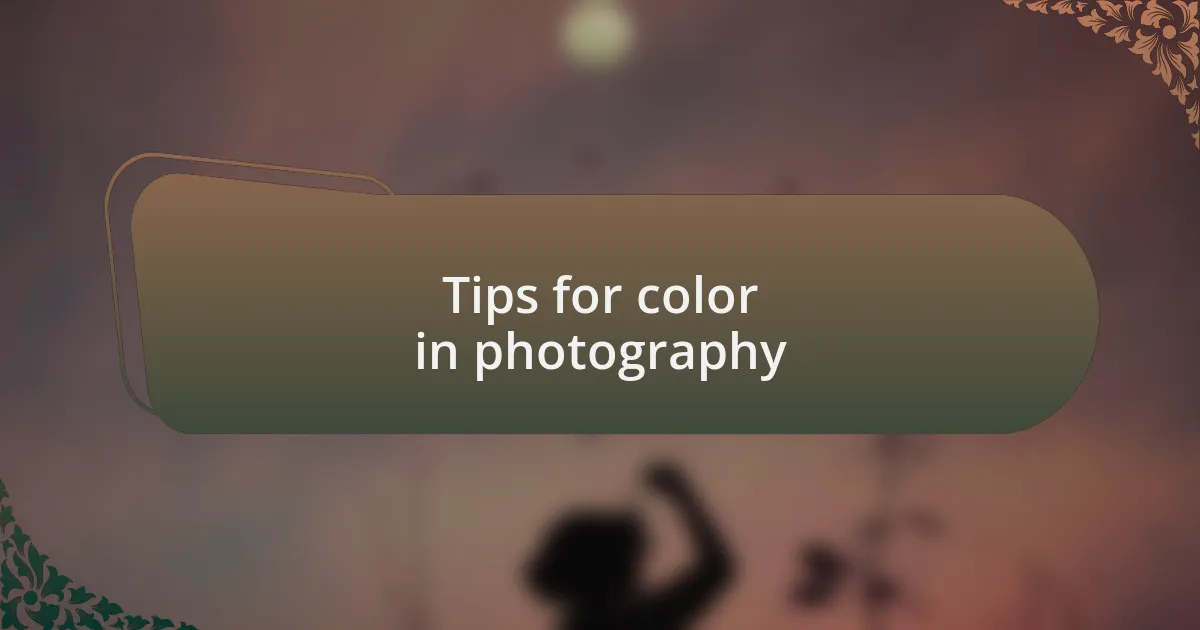
Tips for color in photography
When it comes to color in photography, I often find that pre-visualization is key. During one of my urban explorations, I planned my shots around the vibrant hues of street art, allowing those colors to influence my subject choices. Do you think about how the colors in your composition can enhance the story you wish to tell?
Sometimes, experimenting with color grading can elevate your photos to another level. I recall an incredibly moody forest scene where I went back to the editing software and adjusted the greens to be more vivid while cooling down the background blues. This decision turned a simple image into an ethereal experience. Have you ever thought about how post-processing can completely transform the emotional impact of your art?
In my experience, using color to evoke a specific feeling can create a powerful connection with the viewer. I once captured a striking portrait of a dancer draped in flowing red fabric against a stark black background. This dramatic choice not only popped visually but also conveyed passion and intensity, drawing people into the emotion of the moment. Have you played with color in ways that evoke deep feelings in your audience?